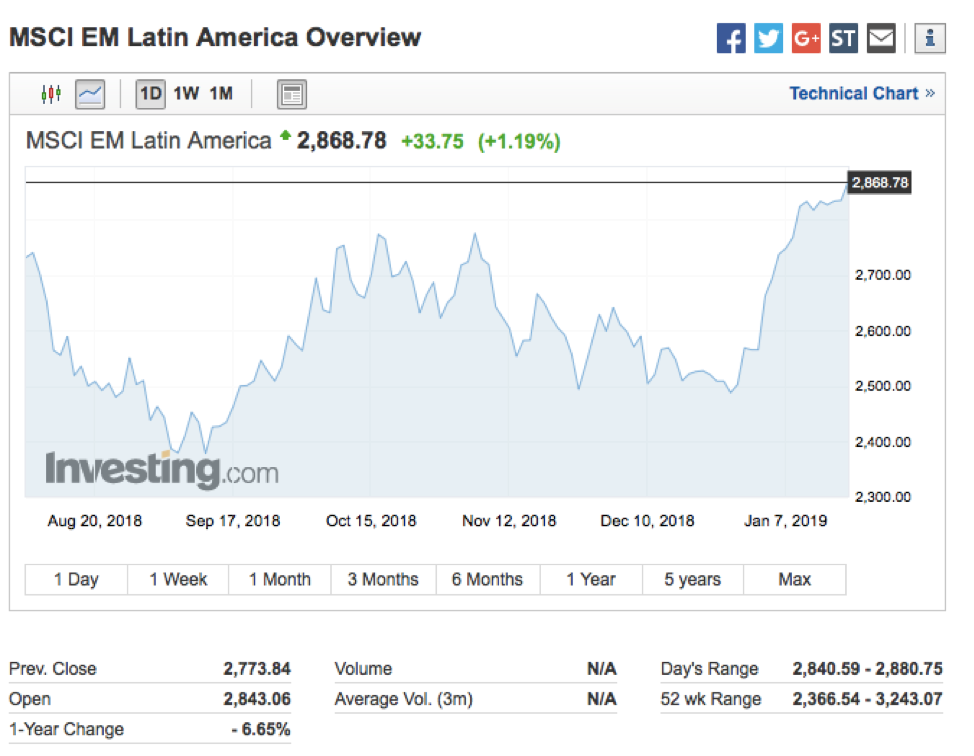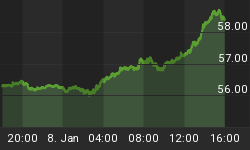With the crisis in Venezuela and more than a dozen major presidential elections in only two years, investor appetites for Latin American stocks riding a precarious wave of instability had dwindled—but the hunger is now re-emerging, with Brazil becoming all the rage.
So far this year has been the start of a Latin America comeback, now that 14 presidential votes are over and there’s room for investors to think optimistically about stability and reform, excluding Venezuela, of course. They’re eyeing a boost in economic growth that has attracted new emerging market investment money.
The iShares MSCI Brazil ETF has gained over 13 percent year to date, while it’s Mexico counterpart has gained over 9 percent. The iShares MSCI Brazil Small-Cap ETF has gained over 10 percent, while the Franklin FTSE Brazil ETF has gained nearly 14 percent. Similar gains have been tracked for Colombia-related ETFs.
And gains in the MSCI EM Latin America Index since the beginning of the year have been over 10 percent:

(Click to enlarge)
The optimism is high enough for some to entertain the idea of a new bull-market phase, and Brazil is the highlight.
Citing a Banco Santander survey of investors who attended the annual Latin American CEO conference, Bloomberg noted that 68 percent pegged Brazil to be the top Latin America performer in 2019. Related: The TSA Could Decide The Fate Of The Government
Likewise, Bloomberg also pointed to a Bank of America Merrill Lynch survey from this month showing that 90 percent expect Brazil to end the year ahead of the game in terms of stocks.
For now, the winning sentiment is that Brazil’s new administration will make good on its promises to make the market more friendly to foreign investors, including via privatization.
But the jury is still out, and a key indicator will be President Jair Bolsonaro’s performance at the World Economic Forum at Davos this week, where he will present the government’s reform plans, which include the tricky issue of pensions.
It’s optimism with a hearty dose of caution.
"If delivered, a reformist and liberal agenda should unlock value of assets in Brazil, with positive revision of profits, lower perception of risk and greater allocation to shares in Brazil," analysts at XP Investimentos said in a note carried by Reuters.
But unlocking that value means betting on things not falling apart, Latin American-style. One kink in that chain is an ongoing investigation into cash transfers to the account of Flavio Bolsonaro, the president’s son.
Related: Private Firms Spent Record $93 Billion On Natural Resources
And global growth fears may tie this bull down before it gets out of the gate.
Already today, investors are showing signs of cold feet, with Sao Paulo’s benchmark Bovespa index falling 0.2 percent amid global growth concerns spurred by weak economic data coming out of China. It didn’t help that the IMF lowered its global growth forecasts on Monday as well. The response has been a strengthening of the U.S. dollar as investors move out of riskier bets, which include emerging market currencies, Reuters reported.
“EM assets are taking a breather as global growth concerns remain high … optimism of trade is fading too,” Reuters quoted Morgan Stanley analysts as saying in note to clients.
Overall, though, analysts speaking with Bloomberg tend to see Latin America as the only opportunity in emerging markets right now.
“Against a challenging backdrop for emerging markets, Latin America is the only region which should do better than in 2018,” Anjeza Kadilli, a Geneva-based economist at Pictet Asset Management SA, wrote in a note. “Elections have led to the establishment of governments willing to reform the public sector and to stimulate the economy through long-term policies.”
By Michael Kern for Safehaven.com
More Top Reads From Safehaven.com

















